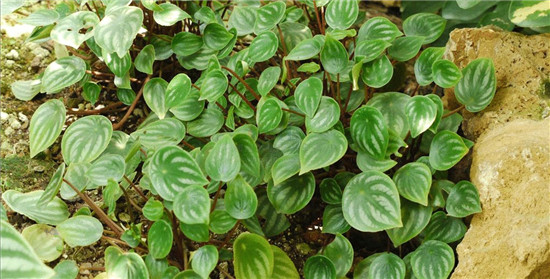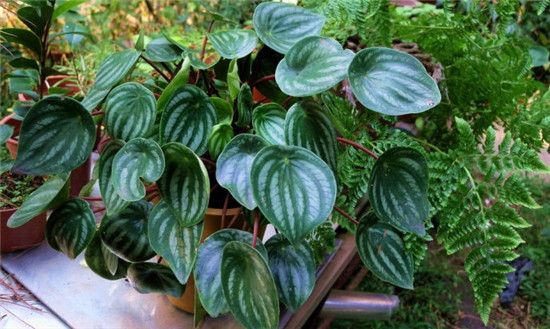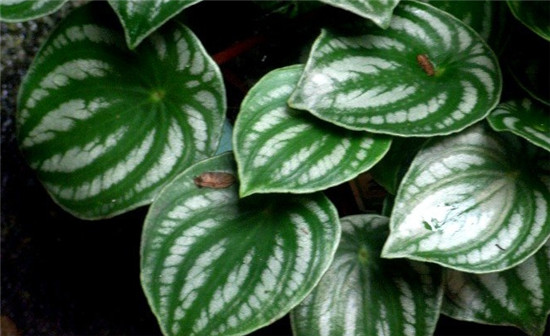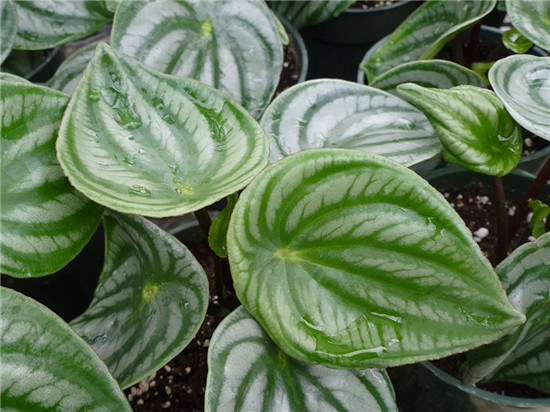[watermelon peel pepper grass] how to maintain watermelon pepper grass
Watermelon pepper grass, also known as bean green pepper grass, is a perennial herb, and then let's take a look at how to maintain watermelon pepper grass.

Watermelon pepper grass, also known as green pepper grass, is a perennial herb, evergreen all the year round, native to South America and tropical regions. The stem is short and tufted, and the petiole is reddish brown. Leaves ovoid, tail tip pointed, about 6cm. Leaf veins radiate from the center to all sides, 8 main veins, dark green, silver gray between veins, shaped like watermelon peel, hence the name watermelon peel pepper grass.
The optimum temperature for growth was 20-28 ℃, but the growth was slow when the temperature was over 30 ℃ and below 15 ℃. The cold resistance is poor, and the lowest indoor temperature should not be lower than 10 ℃ in winter, otherwise it is vulnerable to frost injury. Ramet and leaf cuttings are commonly used for propagation.
Culture method of watermelon peel pepper grass
1. The soil should be fertile
Watermelon pepper grass needs to be cultivated in loose, fertile, well-drained soil and grows poorly in clay. The basin soil should be mixed with coarse sand or cinder ash. It can also be cultivated with peat soil and perlite.

2. The amount of water should be moderate.
It is necessary to keep the basin soil moist during the growing season, but there can be no stagnant water in the basin, otherwise the roots and leaves will rot easily, and even the whole plant will die. In summer and dry season, water should be sprayed on the leaf surface 2-3 times a day to increase air humidity and promote the formation of leaf markings. Fear of both drought and waterlogging, drought will wilt, yellow, or even death; waterlogging will produce root rot. The basin soil can be kept slightly moist, and it can also be watered when the basin soil surface is dry. In winter, if the temperature is slightly lower, watering should be controlled to make the basin soil dry and wet alternately.
3. Adequate humidity
Need high air humidity, not resistant to drying, in addition to normal watering, but also often spray water to the plant, if there are conditions, it is best to sprinkle water to humidify the growth environment, the effect is good. The growth of leaves is extremely abnormal in a dry environment.
4. The light should be dark.
Because the watermelon skin pepper grass is more shady, so usually should be placed in the indoor bright scattered light, avoid strong light direct. Spring and autumn should be moved to a well-ventilated and slightly sunny place for maintenance. Like semi-overcast or scattered light, can only be maintained in the whole sun in winter, shade 50% in summer, otherwise it is easy to burn leaves. But too shady, the leaves are dim, grayish green, and the markings are not obvious.
5. The temperature should be suitable.
The optimum temperature for growth is 20-30 ℃. When the temperature is more than 30 ℃ and below 15 ℃, the growth becomes slow. The lowest temperature in winter should not be lower than 10 ℃, otherwise it is vulnerable to freezing injury. Even physiological ☆ banned ☆ disease.

Causes of root rot of watermelon peel and pepper
Watermelon peel pepper grass bogey strong light direct light, like sufficient astigmatism, usually put in the semi-shady place to cultivate. Watermelon and pepper grass has strict requirements for water. It is OK to keep the basin soil moist during the growing season, but there can be no stagnant water in the basin, otherwise it is easy to rot roots and leaves, or even the death of the whole plant; the cold tolerance of watermelon pepper grass is relatively poor, the optimum temperature for growth is 20-30 ℃, and the lowest temperature in winter can not be lower than 10 ℃, otherwise it is vulnerable to freezing damage, and water temperature should be controlled in winter. Too cold water will also cause plant rot. Watermelon pepper grass rarely has diseases, but it is often infected with Phytophthora in the process of reproduction or adult stage, resulting in stem base and leaf rot.
Solution to root rot of watermelon peel and pepper
1. Too much watering
The most common cause of watermelon peel pepper root rot is that it is caused by too much watering. if the rot is not too serious, you can put it in a place where there is enough scattered light. Pay attention to do not change the basin to water at this time, and then manage normally when the rot becomes dry and healed. If the rot is serious, you can cut off the top with two or three leaves, or cut off a leaf with a stem of about 0.5 centimeters, soak it in loose soil, and it is easy to root in a cool place.

2. The water temperature is too low
After winter, watermelon pepper grass needs to control the water temperature. If the water temperature is lower than room temperature, it will cause root rot due to freezing. Generally, the plant is better watered or sprayed with mild calcium-free soft water.
3. Phytophthora infestation
Phytophthora infestation is another cause of root rot of watermelon peel and pepper. In this case, careful care should be taken not to get too wet, do everything possible to lower the humidity, do not splash soil to the base of the plant stem when watering, and drain water in time after rain to prevent moisture retention. Spraying 27% copper noble suspension at the initial stage of the disease could kill 2000 dry suspension 1000 times, 70% ethyl phosphine ·manganese zinc wettable powder 1000 times, and 70010 Baidefu wettable powder 500,700 times.
The above is the whole content of how to take care of watermelon and pepper grass that I summarized for you. I hope this article can help you. Please continue to follow us.
The above is the whole content of how to take care of watermelon and pepper grass that I summarized for you. I hope this article can help you. Please continue to follow us.
Related
- Wuhan Hospital Iron Tree Blooming Result Was Instantly Frightened by the Gardener Master
- Which variety of camellia is the most fragrant and best? Which one do you like best?
- What is the small blue coat, the breeding methods and matters needing attention of the succulent plant
- Dormancy time and maintenance management of succulent plants during dormancy
- Minas succulent how to raise, Minas succulent plant pictures
- What are the varieties of winter succulent plants
- How to raise succulent plants in twelve rolls? let's take a look at some experience of breeding twelve rolls.
- Attention should be paid to water control for succulent plants during dormant period (winter and summer)
- Watering experience of twelve rolls of succulent plants
- Techniques for fertilizing succulent plants. An article will let you know how to fertilize succulent plants.



